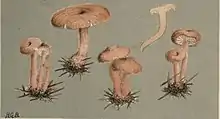| Armillaria socialis | |
|---|---|
 | |
| Scientific classification | |
| Domain: | Eukaryota |
| Kingdom: | Fungi |
| Division: | Basidiomycota |
| Class: | Agaricomycetes |
| Order: | Agaricales |
| Family: | Physalacriaceae |
| Genus: | Armillaria |
| Species: | A. socialis |
| Binomial name | |
| Armillaria socialis | |
| Synonyms | |
|
Agaricus socialis DC. (1815) | |
Armillaria socialis is a species of fungus in the family Physalacriaceae. It is a plant pathogen. Originally described by Augustin Pyramus de Candolle in 1815, it was transferred to Armillaria by Victor Fayod in 1889.[1] It is found in Asia, Europe, and North America.[2]
See also
References
- ↑ Fayod MV. (1889). "Prodrome d'une histoire naturelle des Agaricinés". Annales des Sciences Naturelles, Botanique. 9 (VII): 181–411.
- ↑ Pegler DN (2000). "Taxonomy, nomenclature and description of Armillaria". In Fox RTV (ed.). Armillaria Root Rot: Biology and Control of Honey Fungus. Intercept. pp. 81–93. ISBN 1-898298-64-5.
This article is issued from Wikipedia. The text is licensed under Creative Commons - Attribution - Sharealike. Additional terms may apply for the media files.